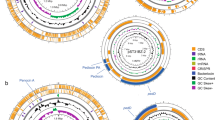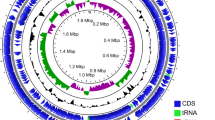Abstract
Lactic acid bacteria (LAB) are widely used in the food industry. Pediococcus spp. belong to the LAB group and include several species that are essential for the quality of fermented food. Pediococcus pentosaceus is the species that is most frequently isolated from fermented food and beverages but its uncontrolled growth during food fermentation processes can contribute to undesired flavours. Hence, the characterisation of these bacteria at the strain level is of great importance for the quality of fermented products. Despite their importance, misidentification at the species level is common for members of the genus Pediococcus. To clarify the taxonomic relationships among strains, a multilocus sequencing approach was developed for the characterisation of a collection of 29 field strains, 1 type strain and 1 reference strain of P. pentosaceus isolated from food. These strains were also tested for several phenotypic properties of technological interest and for the production of bacteriocins. The chromosomal operon involved in the synthesis of the bacteriocin penocin was also investigated. The present study enabled a good genomic characterisation, identifying 17 sequence types, with an overview of phenotypic characteristics related to different technological abilities, and also provides a thorough characterisation of the operon involved in penocin production.



Similar content being viewed by others
References
Altschul SF, Gish W, Miller W, Myers EW, Lipman DJ (1990) Basic local alignment search tool. J Mol Biol 215:403–410
Bisharat N, Cohen DI, Maiden MC, Crook DW, Peto T, Harding RM (2007) The evolution of genetic structure in the marine pathogen, Vibrio vulnificus. Infect Genet Evol 7:685–693
Bolotin A, Wincker P, Mauger S, Jaillon O, Malarme K, Weissenbach J, Ehrlich SD, Sorokin A (2001) The complete genome sequence of the lactic acid bacterium Lactococcus lactis spp. Lactis IL1403. Genome Res 11:731–753
Bruen TC, Philippe H, Bryant D (2006) A simple and robust statistical test for detecting the presence of recombination. Genetics 172:2665–2681
Cai H, Rodriguez BT, Zhang W, Broadbent JR, Steele JL (2007) Genotypic and phenotypic characterization of Lactobacillus casei strains isolated from different ecological niches suggests frequent recombination and niche specificity. Microbiology 153:2655–2665
Calmin G, Lefort F, Belbahri L (2008) Multi-loci sequence typing (MLST) for two lacto-acid bacteria (LAB) species: Pediococcus parvulus and P. damnosus. Mol Biotechnol 40:170–179. doi:10.1007/s12033-008-9073-4
Campelo AB, Gaspar P, Roces C, Rodríguez A, Kok J, Kuipers OP, Neves AR, Martínez B (2011) The Lcn972 bacteriocin-encoding plasmid pBL1 impairs cellobiose metabolism in Lactococcus lactis. Appl Environ Microbiol 77:7576–7585. doi:10.1128/AEM.06107-11
Carraro L, Maifreni M, Bartolomeoli I, Martino ME, Novelli E, Frigo F, Marino M, Cardazzo B (2011) Comparison of culture-dependent and -independent methods for bacterial community monitoring during Montasio cheese manufacturing. Res Microbiol 162:231–239. doi:10.1016/j.resmic.2011.01.002
Christensen GD, Simpson WA, Younger JJ, Baddour LM, Barrett FF, Melton DM, Beachey EH (1985) Adherence of coagulase-negative staphylococci to plastic tissue culture plates: a quantitative model for the adherence of staphylococci to medical devices. J Clin Microbiol 22:996–1006
Coton E, Rollan G, Bertrand A, Lonvaud-Funel A (1998) Histamine producing lactic acid bacteria in wines: early detection, frequency and distribution. Am J Enol Vitic 49:199–204
Dalmış Ü, Soyer A (2008) Effect of processing methods and starter culture (Staphylococcus xylosus and Pediococcus pentosaceus) on proteolytic changes in Turkish sausages (sucuk) during ripening and storage. Meat Sci 80:345–354. doi:10.1016/j.meatsci.2007.12.022
De Brabandere AG, De Baerdemaeker JG (1999) Effects of process conditions on the pH development during yogurt fermentation. J Food Eng 41:221–227
De las Rivas B, Marcobal A, Muñoz R (2004) Allelic diversity and population structure in Oenococcus oeni as determined from sequence analysis of housekeeping genes. Appl Environ Microbiol 70:7210–7219
De las Rivas B, Marcobal A, Muñoz R (2006) Development of a multilocus sequence typing method for analysis of Lactobacillus plantarum strains. Microbiology 152:85–93
Delétoile A, Passet V, Aires J, Chambaud I, Butel MJ, Smokvina T, Brisse S (2010) Species delineation and clonal diversity in four Bifidobacterium species as revealed by multilocus sequencing. Res Microbiol 161:82–90. doi:10.1016/j.resmic.2009.12.006
Diancourt L, Passet V, Chervaux C, Garault P, Smokvina T, Brisse S (2007) Multilocus sequence typing of Lactobacillus casei reveals a clonal population structure with low levels of homologous recombination. Appl Environ Microbiol 73:6601–6611
Didelot X, Falush D (2007) Inference of bacterial microevolution using multilocus sequence data. Genetics 175:1251–1266
Diep DB, Godager L, Brede D, Nes IF (2006) Data mining and characterization of a novel pediocin-like bacteriocin system from the genome of Pediococcus pentosaceus ATCC 25745. Microbiology 152:1649–1659
Dobson CM, Deneer H, Lee S, Hemmingsen S, Glaze S, Ziola B (2002) Phylogenetic analysis of the genus Pediococcus, including Pediococcus claussenii sp. nov., a novel lactic acid bacterium isolated from beer. Int J Syst Evol Microbiol 52:2003–2010
Francisco AP, Bugalho M, Ramirez M, Carrico JA (2009) Global optimal eBURST analysis of multilocus typing data using a graphic matroid approach. BMC Bioinformatics 10:152
Huson DH, Bryant D (2006) Application of phylogenetic networks in evolutionary studies. Mol Biol Evol 23:254–267
Jolley KA, Maiden MC (2010) BIGSdb: scalable analysis of bacterial genome variation at the population level. BMC Bioinformatics 11:595. doi:10.1186/1471-2105-11-595
Kjos M, Nes IF, Diep DB (2009) Class II one-peptide bacteriocins target a phylogenetically defined subgroup of mannose phosphotransferase systems on sensitive cells. Microbiology 155:2949–2961. doi:10.1099/mic.0.030015-0
Lazzi C, Bove CG, Sgarbi E, Gatti M, La Gioia F, Torriani S, Neviani E (2009) Application of AFLP fingerprint analysis for studying the biodiversity of Streptococcus thermophilus. J Microbiol Meth 79:48–54. doi:10.1016/j.mimet.2009.07.021
Leroy F, De Vuyst L (2004) Lactic acid bacteria as functional starter cultures for the food fermentation industry. Trends Food Sci Tech 15:67–78. doi:10.1016/j.tifs.2003.09.004
Librado P, Rozas J (2009) DnaSP v5: a software for comprehensive analysis of DNA polymorphism data. Bioinformatics 25:1451–1452. doi:10.1093/bioinformatics/btp187
Maiden MC, Bygraves JA, Feil E, Morelli G, Russell JE, Urwin R, Zhang Q, Zhou J, Zurth K, Caugant DA, Feavers IM, Achtman M, Spratt BG (1998) Multilocus sequence typing: a portable approach to the identification of clones within populations of pathogenic microorganisms. Proc Natl Acad Sci USA 95:3140–3145
Maifredi M, Marino M, Conte L (2004) Lactic acid fermentation of Brassica rapa: chemical and microbial evaluation of a typical Italian product (brovada). Eur Food Res Technol 218:469–473
Makarova K, Slesarev A, Wolf Y, Sorokin A, Mirkin B, Koonin E, Pavlov A, Pavlova N, Karamychev V, Polouchine N, Shakhova V, Grigoriev I, Lou Y, Rohksar D, Lucas S, Huang K, Goodstein DM, Hawkins T, Plengvidhya V, Welker D, Hughes J, Goh Y, Benson A, Baldwin K, Lee JH, Díaz-Muñiz I, Dosti B, Smeianov V, Wechter W, Barabote R, Lorca G, Altermann E, Barrangou R, Ganesan B, Xie Y, Rawsthorne H, Tamir D, Parker C, Breidt F, Broadbent J, Hutkins R, O’Sullivan D, Steele J, Unlu G, Saier M, Klaenhammer T, Richardson P, Kozyavkin S, Weimer B, Mills D (2006) Comparative genomics of the lactic acid bacteria. Proc Natl Acad Sci USA 103:15611–15616
Manca de Nadra MC, Strasser de Saad AM (1995) Polysaccharide production by Pediococcus pentosaceus from wine. Int J Food Microbiol 27:101–106
Martin DP, Williamson C, Posada D (2005) RDP2: recombination detection and analysis from sequence alignments. Bioinformatics 21:260–262
Mora D, Fortina MG, Parini C, Ricci G, Gatti M, Giraffa G, Manachini PL (2002) Genetic diversity and technological properties of Streptococcus thermophilus strains isolated from dairy products. J Appl Microbiol 93:278–287
Nadkarni MA, Martin FE, Jacques NA, Hunter N (2002) Determination of bacterial load by real-time PCR using a broad-range (universal) probe and primer set. Microbiology 148:257–266
Ortu S, Felis GE, Marzotto M, Deriu A, Molicotti P, Sechi LA, Dellaglio F, Zanetti S (2007) Identification and functional characterization of Lactobacillus strains isolated from milk and Gioddu, a traditional Sardinian fermented milk. Int Dairy J 17:1312–1320
Osborne JP, Mira de Orduna R, Pilone G, Liu SQ (2000) Acetaldehyde metabolism by wine lactic acid bacteria. FEMS Microbiol Lett 191:51–55
Pereira CS, Santos AJ, Bejerano-Sagie M, Correia PB, Marques JC, Xavier KB (2012) Phosphoenolpyruvate phosphotransferase system regulates detection and processing of the quorum sensing signal autoinducer-2. Mol Microbiol 84:93–104. doi:10.1111/j.1365-2958.2012.08010.x
Pfannebecker J, Fröhlich J (2008) Use of a species-specific multiplex PCR for the identification of pediococchi. Int J Food Microbiol 128:288–296. doi:10.1016/j.ijfoodmicro.2008.08.019
Rasmussen TB, Danielsen M, Valina O, Garrigues C, Johansen E, Pedersen MB (2008) Streptococcus thermophilus core genome: comparative genome hybridization study of 47 strains. Appl Environ Microbiol 74:4703–4710. doi:10.1128/AEM.00132-08
Santos EM, Jaime I, Rovira J, Lyhs U, Korkeala H, Björkroth J (2005) Characterization and identification of lactic acid bacteria in “morcilla de Burgos”. Int J Food Microbiol 97:285–296
Schillinger U, Lücke F (1989) Antibacterial activity of Lactobacillus sake isolated from meat. Appl Environ Microbiol 55:1901–1906
Sharpe ME (1979) Identification of the lactic acid bacteria. In: Skinner FA, Lovelock DW (eds) Identification methods for microbiologists. Academic Press, London, pp 233–259
Simpson PJ, Stanton C, Fitzgerald GF, Ross RP (2002) Genomic diversity within the genus Pediococcus as revealed by randomly amplified polymorphic DNA PCR and pulsed-field gel electrophoresis. Appl Environ Microbiol 68:765–771
Stiles ME (1996) Biopreservation by lactic acid bacteria. Antonie Van Leeuwenhoek 70:331–345
Tanganurat W, Quinquis B, Leelawatcharamas V, Bolotin A (2009) Genotypic and phenotypic characterization of Lactobacillus plantarum strains isolated from Thai fermented fruits and vegetables. J Basic Microbiol 49:377–385. doi:10.1002/jobm.200800185
Thomas TD, McKay LL, Morris HA (1985) Lactate metabolism by pediococci isolated from cheese. Appl Environ Microbiol 49:908–913
Titgemeyer F, Hillen W (2002) Global control of sugar metabolism: a gram-positive solution. Antonie Van Leeuwenhoek 82:9–71
Vos M, Didelot X (2009) A comparison of homologous recombination rates in 805 bacteria and archaea. ISME J 3:199–208. doi:10.1038/ismej.2008.93
Acknowledgments
This publication made use of the P. pentosaceus MLST website (http://pubmlst.org/ ppentosaceus/) developed by Keith Jolley and sited at the University of Oxford (Jolley and Maiden 2010). The development of this site has been funded by the Wellcome Trust.
Author information
Authors and Affiliations
Corresponding author
Electronic supplementary material
Below is the link to the electronic supplementary material.
Rights and permissions
About this article
Cite this article
Martino, M.E., Maifreni, M., Marino, M. et al. Genotypic and phenotypic diversity of Pediococcus pentosaceus strains isolated from food matrices and characterisation of the penocin operon. Antonie van Leeuwenhoek 103, 1149–1163 (2013). https://doi.org/10.1007/s10482-013-9897-1
Received:
Accepted:
Published:
Issue Date:
DOI: https://doi.org/10.1007/s10482-013-9897-1




